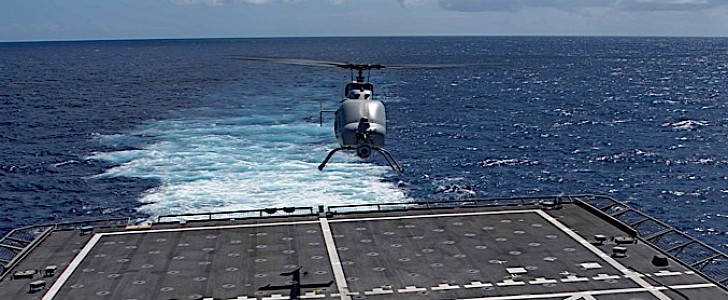Back in the year 2000, which is more than two decades in our past, Northrop Grumman introduced in its lineup of military something called MQ-8 Fire Scout. The helicopter drone, in a configuration called MQ-8B, entered active service in 2009 and is old enough for the company and U.S. Navy to presently test a bigger, newer version called MQ-8C.
The C passed “the initial fit check” on board the San Antonio-class amphibious transport dock USS Anchorage (LPD-23) about a year ago. Since then, testing of the thing seems to have accelerated, and the drone is reaching milestones like there’s no tomorrow.
The most recent achievement involved the Independence-variant littoral combat ship USS Jackson (LCS 6). On location in the Philippine Sea last week, the ship saw an MQ-8C complete return to flight operations and conduct missions alongside an MH-60S Seahawk helicopter.
“It’s great to be flying the MQ-8C again, especially for an extended period with our MH-60S,” said in a statement Lt. Cmdr. Richard Mooney, head of Helicopter Sea Combat Squadron 23 attached to the Jackson.
“Coordinated manned-unmanned operations like these provide numerous advantages to our surface combatants.”
Up next for the drone is further testing “with other ships and airborne assets as operations require,” but there is no definite date for when it will be fully operational and ready to deploy.
The Fire Scout, no matter the version, is based on the commercially available Bell 407 helicopter, only it comes with no need for a pilot. It was specifically designed for intelligence, surveillance, reconnaissance (ISR) and target-acquisition operations. The way it was made makes it capable of taking off from and landing on ships, but also on unprepared areas elsewhere, if need be.
The thing is powered by a Rolls-Royce engine that gives it a top speed of 132 mph (213 kph) and can stay airborne for about eight hours.
The most recent achievement involved the Independence-variant littoral combat ship USS Jackson (LCS 6). On location in the Philippine Sea last week, the ship saw an MQ-8C complete return to flight operations and conduct missions alongside an MH-60S Seahawk helicopter.
“It’s great to be flying the MQ-8C again, especially for an extended period with our MH-60S,” said in a statement Lt. Cmdr. Richard Mooney, head of Helicopter Sea Combat Squadron 23 attached to the Jackson.
“Coordinated manned-unmanned operations like these provide numerous advantages to our surface combatants.”
Up next for the drone is further testing “with other ships and airborne assets as operations require,” but there is no definite date for when it will be fully operational and ready to deploy.
The Fire Scout, no matter the version, is based on the commercially available Bell 407 helicopter, only it comes with no need for a pilot. It was specifically designed for intelligence, surveillance, reconnaissance (ISR) and target-acquisition operations. The way it was made makes it capable of taking off from and landing on ships, but also on unprepared areas elsewhere, if need be.
The thing is powered by a Rolls-Royce engine that gives it a top speed of 132 mph (213 kph) and can stay airborne for about eight hours.






